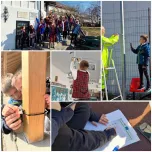In the spring of 2024, Volens Association implemented CleanAir@School, a citizen science initiative aimed at monitoring air quality, for the first time in public Romanian schools. CleanAir@School, created by 4sfera Innova (Spain) is part of the GreenSCENT framework.
A partnership enabled by the Education for Climate community.
Ever since GreenCOMP framework was published, we started helping Romanian teachers incorporate it into their work. At one of the E4C gatherings, I found out about GreenSCENT project, which also focuses on green competencies for behavioral change. I reached out to UNINETTUNO (Italy), one of the institutions involved, who gracefully accepted to become our partner for implementing the first GreenSCENT external pilot in Romania. One of its components was CleanAir@School - an educational resource that encourages pupils to study air pollution on a scientific basis while developing competencies such as systems thinking, problem framing, exploratory thinking, and collective action.
The project was implemented by Volens Association, in partnership with UNINETTUNO and 4sfera Innova and with the support of Heidelberg Materials Romania, between November 2023 – May 2024 in 5 schools from Dambovita County, including both urban and rural settings. Primary and secondary school educational levels were included.
Trans-disciplinary learning about air pollution while building sustainability competencies.
Fifteen teachers and 170 students (between 7– 16 years old) were trained in using passive sensors, as physical equipment, and digital tools, to collect data about the quality of the air in their communities.
4sfera Innova provided 20 passive samplers per school, along with digital educational materials. We guided the teachers to integrate the topic of air pollution into their classes. The teachers adapted the learning units to the age of their pupils, using flexible teaching methods such as experiential learning, collaborative learning, and trans-disciplinary learning. After becoming familiar with the effects of nitrogen dioxide (NO2) on human health and the ecosystem, the teachers and students went on to choose the appropriate locations where to place the sensors that would absorb NO2 from the surrounding air for the following 4 weeks.
Educational resources combine theoretical, practical, and digital tools.
The selection of the places was a collaborative learning experience, because they had to follow certain criteria (inside the school, the schoolyard, most common routes the students take coming to school, etc.). After four weeks, the sensors were collected and sent to 4sfera for data analysis and reporting.
Throughout the entire process, teachers and students had to use two digital tools – an interactive online map and a mobile application. These instruments encouraged pupils, even the younger ones (8-10 y.o.) to be rigorous, and methodical and work with scientific concepts. It was an essential exercise of critical data-based thinking.
CleanAir@School combines theoretical, scientific, practical, and digital learning.
Using data to stimulate critical, systemic, and exploratory thinking and behavioral change
The 4sfera report was a very helpful learning resource, as it presented a visual representation of how the NO2 concentrations vary according to the intensity of traffic, the proximity of parks and green spaces, and industrial activity. After receiving the report, each team got together to share and make sense of the results, review their work, and set up a strategy for changing habits and raising awareness in the community. Even though the report proved that air pollution levels are not above the normal average in any of the communities, the variations in nitrogen dioxide concentrations between the various locations got the school talking and debating.
CleanAir@School was the first project of this kind for the participating schools, situated in small countryside communities, where such opportunities arise rarely. Pupils welcomed the interdisciplinary, practical nature of the project that helped to contextualize the theoretical knowledge learned in class.
Teachers and students consider that CleanAir@School fostered collaboration between the school and the community in a way that exceeded their expectations. Students mentioned CleanAir@School among the top three most interesting non-formal experiences of the whole school year, stating it developed their problem-solving abilities and interest in science and teamwork. The teachers gained new skills in turning learning into a participatory process, aimed at strengthening sustainable development competencies.





Please log in or sign up to comment.